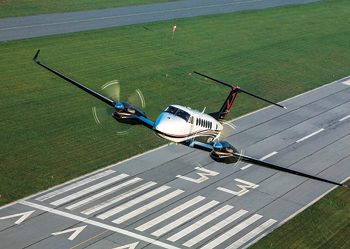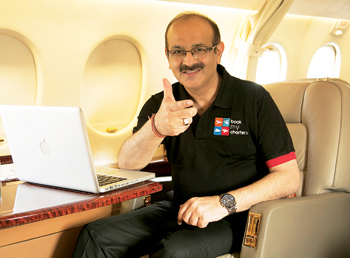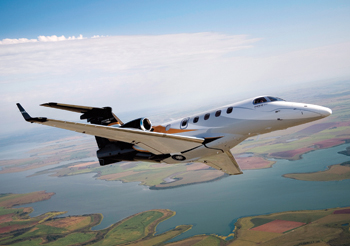A Concept Yet to Take-off
Unlike a charter, where one has to charter the entire aircraft with accoutrements that comes with it, air taxi runs on ‘pay per seat’ basis and not ‘pay per aircraft’

On and off, we hear in the media that some players intend to start ‘air taxi’ operations in states such as Madhya Pradesh, Odisha, Uttar Pradesh, Gujarat, etc. In February this year, the Uttar Pradesh Government was contemplating allowing private players to start air taxi operations to boost tourism. This topic comes up often in the media but we have not seen anything materialise.
However, the first question that comes to mind is – what is ‘air taxi’? The US Federal Aviation Administration sees no difference between ‘air taxi’ and ‘air charter’ (a term said to have been popularised by Fred Gevalt at the Air Charter Guide). According to Glenn Phillips of Air Charter Services, UK, “Air taxis are on-demand flights from point A to point B in a small aircraft. Most times the aircraft is so small that if you stand in the aircraft, your head will be touching the ceiling.” The Air Charter Services India website mentions private charter air taxi services but Phillips clarified that the India operations do not ply air taxis.
Air taxi operations in developed countries are similar to ‘shared cab’ services wherein a customer pays for either a one-way or round trip fare to his or her destination and that flight may have other customers too. Unlike a charter, where one has to charter the entire aircraft with accoutrements that comes with it, air taxi runs on ‘pay per seat’ basis and not ‘pay per aircraft’. Air taxis are planned to run regular routes and the preferred aircraft size is small or very light jets, considering the nature of ‘shared services’ business. Very light jets are ‘manageable’ as the number of passengers is below 10 and it seems probably easier to get some seats filled up.
DGCA lists out air taxi category
taxi operators shall be air carriers engaged in air transportation of persons, their baggage and of cargo within the territory of the Indian Union. Operations by the air taxi operators shall be charter and/or non-scheduled operations. It shall be necessary to obtain authorisation from the DGCA for each individual flight, and tickets will not be sold to individual passengers. However, on routes not covered by any scheduled operator, an air taxi operator has the option to sell tickets to individual passengers, and it shall also not be necessary to take prior permission of the DGCA for each flight. DGCA states that air taxi operations shall not be permitted to destinations outside India.
For air taxi operations, it could be a multi-engined fixed-wing aircraft and single or multi-engined helicopters. The DGCA states that the pressurised aircraft to be imported for air taxi operations for passenger services shall not be more than 15 years in age or have completed 75 per cent of its design economic cycles or 45,000 pressurisation cycles, whichever is less.
For unpressurised aircraft, and for aircraft to be used solely for freighter services, the decision will be taken on a case to case basis depending on a complete examination of the records of the aircraft being procured. The eligible applicants can import aircraft from their own foreign exchange resources through arranging/buying foreign exchange from the open market as per the rules and regulations of the Ministry of Finance and/or the Reserve Bank of India. Permission for import of specific aircraft suitable for air taxi operations will have to be obtained from the competent authority prior to import. An air taxi operator may, with prior approval of the competent authority, obtain suitable aircraft in the country on lease for air taxi operation. All aircraft, before being used for operations, will be endorsed on the Air Taxi Operators’ Permit.
RCS will Drive Air Taxi Operations: Rajeev Wadhwa

BookMyCharters is India’s online platform for booking private jets and has in its reach a wide array of general/business aviation aircraft. Rajeev Wadhwa of BookMyCharters talks about the air taxi scenario in India.
BizAvIndia: How different is air taxi from air charter?
Rajeev Wadhwa (Rajeev): Air taxi operations are very common in mature markets like the US and Europe where most air taxi operations are sector/route specific and frequency is extremely high. Taking example of New York to Boston route where an operator may have set operations to shuttle between five times a day. Air charter means a customer books an entire aircraft to travel to any destination of his choice whereas air taxi in most cases is a fixed route shuttle service. Air taxi operates on a per seat model whereas air charters are comparatively an expensive proposition. Thus the profile of customer largely differs in both the cases.
BizAvIndia: Are air taxis running in India?
Rajeev: Currently no major operators have taken the initiative to run this service, but with the Regional Connectivity Scheme in place, you will see a surge of air taxi operations in India on popular routes.
BizAvIndia: What are the challenges for air taxi operations?
Rajeev: Air taxi operations work effectively in FBO (fixed-based operator) environment with the presence of dedicated airport infrastructure and low cost of operations. Most of air taxi operators buy fuel at competitive rates and have one type of fleet. The operations are backed by owned FBOs and MROs at less commercial locations for reasons of viability. This infrastructure gap in the Indian aviation industry has discouraged various attempts to commence such services in the past. However, the latest aviation policy which focuses on the Regional Connectivity Scheme and encourages the ‘Make in India’ Initiatives brings a new ray of hope for operators and aviation investors to set up such services along specific routes in the country.
BizAvIndia: Is Baron Group involved in air taxi bookings/operations?
Rajeev: Baron Group has an online platform called bookmycharters. com which currently aggregates 40 aircraft from seven aircraft bases, facilitating air charter bookings to 149 locations in India via 22,000 different routes. The platform is geared to support air taxi operations when it comes to online bookings.
— By R. Chandrakanth

States contemplating air taxis
These regulations have been in place for quite some time and there has been growing interest to start full-fledged air taxi business. Now with Regional Connectivity Scheme to be introduced, the segment will get enormous boost. In February this year, the Government of Madhya Pradesh was thinking of allowing 20-seater private air taxis. The government was planning to connect by small towns, including Lucknow, Varanasi, Agra, Allahabad, Meerut, etc. The service was being launched under the existing ‘Open Sky policy’.
The concept of air taxi is not new in foreign countries though it is a fairly new concept in India. Air taxi service in India started first in 2011 in Madhya Pradesh but was closed down in 2014. Chief Minister Shivraj Singh Chouhan inaugurated India’s first air taxi service at Raja Bhoj Airport in Bhopal, on September 7, 2011. The main objective was to promote tourism in Madhya Pradesh. However, due to some reasons, the air taxi service was closed down last year.
Air taxis are planned to run regular routes and the preferred aircraft size is small or very light jets, considering the nature of ‘shared services’ business.
About 18 companies, including Jet Serve Aviation, Indus Airways, Aryan, Northeast Shuttles, CD Aviation, Fairwinds Aviation, etc, had earlier submitted proposals evincing interest in the service. Some companies had even given presentation before the state tourism department. But, no air service could be launched. Subsequently it was announced by Supreme Transport Aviation that it would resume air taxi services connecting 11 cities of Madhya Pradesh, using Cessna Grand Caravan aircraft. It was announced then that the fares on these taxis would vary between Rs. 3,500 and Rs. 5,000 and the company announced benefits of air taxi – same day travel; reduction in driving time; reduction in time taken for airport check-in and security checks; cost-effective and connecting remote places.
The first test flight was between Indore-Jabalpur-Indore. Supreme Aviation said it would provide air taxi service on the following sectors: Indore-Jabalpur-Indore, Jabalpur-Bhopal-Jabalpur, Bhopal-Satna/Rewa-Bhopal, Satna/Rewa-Varanasi, Bhopal-Nagpur-Bhopal, Nagpur-Kanha, Kanha-Bandhavgarh, Bandhavgarh-Khajuraho, Khajuraho-Agra and Indore-Ahmedabad-Indore. In December 2015, the Madhya Pradesh Tourism Development Corporation cancelled its contract providing subsidy to flights operated by Supreme Transport Aviation. Supreme Airways had planned to connect 12 cities with Indore and Bhopal. It had also planned inter-state operations on Nagpur and Agra routes. The contract was cancelled following inordinate delay in getting the DGCA approval. The Supreme Airways website says it is under construction.
Similarly, Air Odisha Aviation Private Ltd had plans to launch air taxi services from Indore to Jaipur and Ahmedabad. Air Odisha had tied up with Gujarat-based GSEC for air taxi services. The company had earlier planned to launch flights but the launch was postponed. Meanwhile, Air Odisha has landed in trouble with investors in the company claiming that they had been defrauded. Efforts to contact these companies to find out their status of operation proved futile as none of them responded either to telephonic calls or e-mails, thus indicating that there is nothing much happening in the realm of air taxis.





